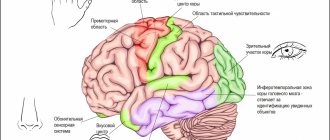Bradylalia is a pathological condition in which speech slows down due to difficulty pronunciation, the inability of a person to make distinct sounds. With this defect, thinking is not impaired; general inhibition, lethargy and loss of strength are observed.
Patients speak slowly, may take long pauses between words, and ask the question again so that there is time to answer.
Bradylalia occurs as an independent disease and can be a complication of mental pathology. The disease develops against the background of brain damage and requires urgent observation by a specialist who will prescribe treatment.
Various reasons lead to the disease:
- burdened heredity;
- damage to the child’s brain during pregnancy;
- various acquired diseases of the central nervous system;
- mental disorders, against the background of which problems with forming words appear;
- defects in education, which gradually lead to improper development of speech.
General information
Bradylalia in children is much less common than other speech development disorders, such as tachylalia (increased speech production speed) or dyslalia. Along with the slow rate of speech, with this pathology, pronounced changes in voice formation are observed: the child begins to speak monotonously, unemotionally, without modulation, that is, without changing the characteristics of the narration (loudness, tempo, pitch). Along with external disturbances, the thought process also suffers, which is reflected in the slow formation of words and sentences before oral reproduction.
Why do you need to correct and treat bradyllia?
Problems with communication can lead to psychological trauma in a child. Low activity and slow speech may interfere with his ability to communicate. As a result, the child may begin to feel shy, become withdrawn, and eventually speak less and less.
However, in this case it is not only a matter of communications, but also development. Low speech activity also reduces the formation of intelligence. This means that the growth of psychological functions - attention, memory, thinking - also suffers.
Developed speech according to age is necessary for mental development. It is for this reason that it is important to start working with a speech therapist as early as possible so that the child can develop and learn.
Reasons for the development of bradyllia in childhood
Experts identify two groups of factors that can directly or indirectly influence the occurrence of pathology. Biological causes include:
- various lesions of the central nervous system in the perinatal and neonatal period (birth injuries, Rh conflict, intrauterine infections);
- regular effects of alcohol, drugs and medications on the fetus during pregnancy;
- neurological diseases;
- traumatic brain injuries;
- infectious brain lesions;
- mental disorders associated with general underdevelopment (oligophrenia).
Many speech therapists and speech pathologists point to a large role in the development of bradyllalia of hereditary predisposition, since in some families a slow speech rate is passed on from generation to generation.
Social and psychological factors include:
- lack of speech education;
- pedagogical neglect;
- excessive mental and emotional stress on the baby;
- unstable psychological situation in the family, when the child prefers to remain silent.
In some cases, children imitate the manner of close or stranger adults speaking slowly: parents, grandparents, TV stars, bloggers.
There is also a variant of the norm, when a slow pace of speech is not accompanied by disturbances in the thought process, reading, writing and articulation, and is an individual feature, which is typical for some northern peoples, people with a phlegmatic type of temperament.
Tips for parents
It is important for the child to create a positive speech environment.
Repeatedly talk through ordinary, daily activities:
dressing, washing, eating, bathing, walking, getting ready for bed, going to bed, cleaning the room and toys, cooking. All these processes must necessarily be accompanied by the speech of adults.
Say nursery rhymes, tongue twisters, proverbs, proverbs, sing songs
.
Talk to your child as often as possible
, listen carefully to his answers to questions. This will not only improve your baby’s speech, but will also establish a trusting relationship between you.
Read together
, discuss what you read, illustrate the plot together, discuss the drawings.
Symptoms of bradyllalia in children
Signs of pathology can be divided into two groups: speech and non-speech disorders. Speech symptoms include:
- slow, as if oral speech is difficult;
- problems with the mental formation of words and sentences;
- deliberate stretching of vowel sounds;
- increased intervals between words, sometimes between individual parts of a word;
- slow reading, writing;
- difficulties in reproducing read text;
- monotonous narration, devoid of emotional coloring;
- lack of voice modulation during verbal communication;
- scanned (fragmentary) speech.
Such violations manifest themselves in any type of independent speech: dialogue, monologue, reading, retelling, reproduction of poetic forms. At the same time, no spelling errors are observed; children with bradyllalia do not experience difficulties in remembering the rules of the language and applying them in practice.
Non-speech signs of pathology include:
- impaired fine motor skills and coordination;
- unnatural or inappropriate facial expressions;
- lethargy;
- clumsiness;
- long “inclusion” in a new type of activity and difficult transfer of attention to another activity;
- problems with following instructions and assigned tasks;
- aimless repetition of the same movements.
As a rule, even young children are well aware of their defect, which further aggravates the disorders. Kids try to communicate with gestures, prefer to avoid active speech, and do not like to meet both peers and adults. The lack of verbal communication affects the mental state of children, which in the future, in the absence of adequate help, can lead to stuttering and serious psycho-emotional disorders.
Diagnostics
If bradyllalia is suspected, a comprehensive medical, psychological and speech therapy examination is indicated. Speech pathologists, speech pathologists, neurologists, psychologists, otorhinolaryngologists, audiologists and other specialized specialists, if necessary, should participate in the diagnosis.
The list of diagnostic procedures includes:
- assessment of oral and written speech, reading pace;
- neuropsychological tests aimed at analyzing fine motor skills, facial and sensory functions, and general intellectual development;
- physiological studies (MRI and PET of the brain, EEG and other techniques).
An assessment of the child’s mental state is also carried out, the language environment, his lifestyle, habits, and characteristics of relationships within the family and with peers are studied.
Advantages of correction of speech disorders in NEARMEDIC
High level of services provided
The quality of services provided by our specialists is eloquently evidenced by the fact that in the rating of private clinics for 2016, the NEARMEDIC network took first place, confidently ahead of other representatives of the industry.
Experienced staff
Classes for bradyllalia are conducted by speech therapists with higher education in defectology, aphasiologists-neurorehabilitation specialists with 18 years of experience, practical psychologists, and neurologists. Among the doctors are teachers from the Institute of Defectology and Medical Psychology, developers of individual development and rehabilitation programs, participants in international and domestic conferences, congresses and symposia.
Correction of bradyllalia
Therapy for speech disorders should be comprehensive.
In relation to bradylalia, specialists use a combination of medication, psychological techniques and speech therapy and pedagogical classes. Medical support includes:
- drugs affecting the central nervous system;
- physiotherapeutic methods;
- physiotherapy;
- massage techniques.
Social-psychological and speech therapy includes:
- speech therapy massage;
- logorhythmic lessons;
- classes aimed at accelerating speech with the help of speech material (tongue twisters, nursery rhymes, poems, rhyming riddles, reading aloud by role).
Teachers and speech therapists-defectologists conduct special classes, the purpose of which is to accelerate the pace of meaningful formation and reproduction of syllables, words and full-fledged phrases. To do this, they use the “conducting” method, when the child is helped to maintain a certain speed of speech with the help of claps, hand waves and other rhythmic signals.
Additionally, specialists can select interesting activities for children with bradyllalia that promote the development of gross and fine motor skills, coordination, spatial and imaginative thinking. These include various physical exercises, sports, manual labor (modelling, drawing, knitting, weaving), playing musical instruments, etc.
Forecast and preventive methods of bradyllia
In general, the prognosis for treatment of speech tempo disorders is favorable, especially if correction of bradyllalia is carried out in the early stages. But still, after speech normalization, the patient needs not only to visit a specialist more often, but also to independently monitor his speech. As for preventive methods of bradyllalia, in this case doctors recommend:
- prevent intrauterine, birth and postpartum lesions of the central nervous system;
- avoid head injuries, neuroinfections;
- carry out measures aimed at preventing the development of asthenic syndrome, namely, follow a daily routine and eat well;
- monitor the child’s speech development;
- fully communicate;
- choose the right role models.
Prognosis and prevention
In general, the prognosis is favorable, although much depends on the individual characteristics of the child, his medical history, environment, and the presence of systemic pathologies. With timely initiation of therapy, bradyllia is completely correctable. The main conditions for a successful result are systematic training and home supervision by adults. On average, the duration of treatment is from 6 to 12 months, but even with excellent results, in the future it will be necessary to regularly conduct speech therapy lessons, and the child will have to learn to independently control the rate of speech until complete automation.
Although there are no specific preventive measures against bradyllalia and other speech disorders, doctors recommend to future and new parents to reduce the risk of developing pathologies:
- be attentive to your health, especially at the stages of planning pregnancy and bearing a child;
- stop using known dangerous substances (nicotine, alcohol, drugs);
- do not take antibacterial, hormonal and other systemic drugs as self-medication;
- pay close attention to the safety of the newborn;
- protect children from traumatic brain injuries, bruises, falls;
- promptly vaccinate children against dangerous infections (meningitis, encephalitis);
- adequately educate preschoolers, devoting sufficient time to the formation of correct speech and the development of fine motor skills;
- do not overload children with responsible tasks or a large volume of intellectual tasks at an early age;
- maintain a healthy microclimate within the family;
- control the child’s communication with adults who have speech impediments;
- stop imitation of people who have any speech disorders (lisp, stuttering, slow speech rate, habit of lisp and swallowing endings).
If a child has diseases of the central nervous system, mental disorders, or general underdevelopment, parents need to act in close tandem with doctors, speech therapists and psychologists to provide the child with comprehensive and adequate care. It is very important not to ignore the prescribed drug treatment, without which, in the case of serious pathologies, speech therapy will be useless.
You can learn more about bradyllalia and methods of its correction in children of different ages, make an appointment with a specialized specialist and get competent help at the SM-Doctor clinic.
Symptoms and features of the disease
The typical clinical picture of bradyllalia is characterized by the following symptoms:
- slow speech rate;
- extended pronunciation of vowels;
- long pauses between words;
- long intervals between homogeneous syllables;
- slow reading and writing;
- additional symptoms: twitching of facial muscles, lethargy, apathy and general lethargy.
Patients with bradyllalia have difficulties with thinking - it is immediately difficult for them to orient themselves in what is happening, they take a long time to delve into some details. Such difficulties arise in severe forms of the disease; a mild degree of pathology affects only speech and slightly worsens a person’s quality of life.
Any form of bradyllalia must be treated, and all patients with this disorder should undergo recovery under the supervision of specialists. The sooner treatment is started, the better the prognosis. In our speech center we are always ready to help people with this problem; we offer rehabilitation using modern safe training without drugs or hypnosis.
In our center you can undergo treatment for childhood stuttering in Moscow. We conduct trainings with leading specialists who have confirmed their skills during practice!








